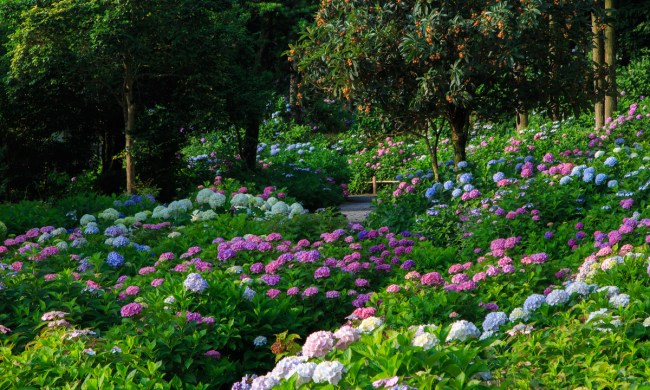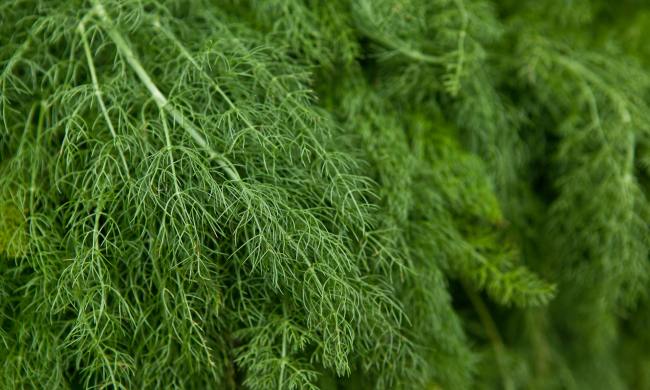Lavender is a blooming herbal plant loved by many across the United States. Even those who don’t garden can recognize its beautiful purple flowers and iconic scent. So when you decide to add lavender to your garden, you might wonder what plants are good drought-tolerant companions for it. Whether you’re building a pollinator garden or wanting to make a charming corner in your garden, these lavender companion plants are perfect!
1. White mugwort
The first on our list is a plant called white mugwort, or Artemisia lactiflora. Although they have a strange name, these plants are stunning and an excellent companion to your aromatic lavender. White mugwort plants look like astilbes and have deep green foliage with silvery undersides and toothed edges. They also feature elegant and creamy white plumes that grow in vertical lines.
The flowers are tiny and appear on the ends with slightly arching stems. From late summer to fall, these blooms bring an airy aesthetic to your garden. They won’t bloom in the early spring like lavender, but when your lavender blooms again in the fall, these mugworts will still be blooming. If you have a lot of big leaved plants and need something to brighten up the space, this is the plant for you. It’s hardy in zones 3 to 8, wants full to partial shade, and can grow 3 to 5 feet tall. It also spreads 2 to 3 feet wide.
2. Red valerian
The red valerian, or Centranthus ruber, is a bushy plant that sends out its branches in thick and strong patterns. It’s very popular in the United States and grown for its stunning, showy flowers. The red valerian is easy to grow and has one of the longest blooming seasons, which means it will bloom alongside your pretty lavender. It doesn’t have too many pests or diseases to deal with either, which makes it low maintenance as well.
The flowers are round and clustered and come in various colors, including crimson, pink, and white. These beautiful flowers appear on the top of blue-green lacey foliage and are very fragrant. You won’t be disappointed with the number of flowers either! The red valerian produces a lot of blooms that bring butterflies to your garden! These beautiful lavender companion plants are hardy in zones 5 to 8 and require full sun. The red valerian grows from 2 to 3 feet tall and can spread 1 to 2 feet wide.
3. Lavender cotton
With a name like lavender cotton, how could this plant disappoint as a lavender companion? We think you’d see this plant, Santolina chamaecyparissus, all across the United States if it weren’t for the hardiness zone restrictions. This heat-loving plant is hardy in zones 6 to 9.
It’s a favorite in Mediterranean gardens and needs full sun to thrive. The lavender cotton is an evergreen shrub loved for its dense and silvery foliage that grows all year round. It blooms in the summer with small button-shaped flowers that are bright yellow, but the bloom schedule won’t line up with lavender, so you’ll have color longer throughout the season. This adorable plant grows up to 2 feet tall and 3 feet wide. If you live in a hot southern state, you can use this plant to add a bit of whimsical aesthetics to your garden.
4. Blue fescue
Blue fescue, or Festuca glauca (“Elijah Blue,”) is a dwarf ornamental grass mostly grown for its bright silvery-blue foliage. It’s densely tufted and finely textured, allowing it to provide your garden with a light and airy feel. It’s the perfect companion to bright purple lavender flowers!
It has needle-shaped leaves, and those blade-like leaves are topped with long and slender flowers. The blooms appear in the same color as the foliage, but then turn to a light tan as they mature. Gardeners often use them as ground cover since they spread into delightful patterns and grow easily. You can also use them around the border of your garden to protect against deer since these are deer-resistant plants!
5. Blanket flower
Are you looking for a bright pop of color in your garden? The blanket flower, or gailardia, is a perennial that adds a burst of orange to your garden that borders on florescent. These long-lasting, colorful, and bright flowers grow in single or double daisy-like patterns on top of gray-green foliage. The eye-catching blooms last from early summer to fall and prefer full sun to thrive.
The blanket plant is named after the Native American blankets with a similar bright, colorful pattern. These flowers grow from 2 to 3 inches wide and attract hummingbirds and butterflies. They are the perfect addition to a pollinator garden, and the orange looks lovely next to the purple blooms of lavender. Blanket flowers also have a wide hardiness range and can grow in zones 3 to 10.
How far apart should you plant lavender?
When planting lavender, each plant should be about 1 to 3 feet apart. Be sure you’re planting in the early spring to give your lavender plenty of time to establish itself so it can survive the winter and come back year after year.
What can you not plant near lavender?
There are many plants you can plant next to lavender, but these are some plants you’ll want to avoid planting next to lavender.
- Mint
- Impatiens
- Camellias
- Hosta
You can add all or one of these lavender-friendly plants and you’ll make your lavender and their companions happy. Be sure to find one that can grow in your climate zone, and you’ll have the reward of pops of color in your garden! If you have drought-prone conditions and want even more bursts of color, these dry soil-loving flowers are perfect for your garden, too.




